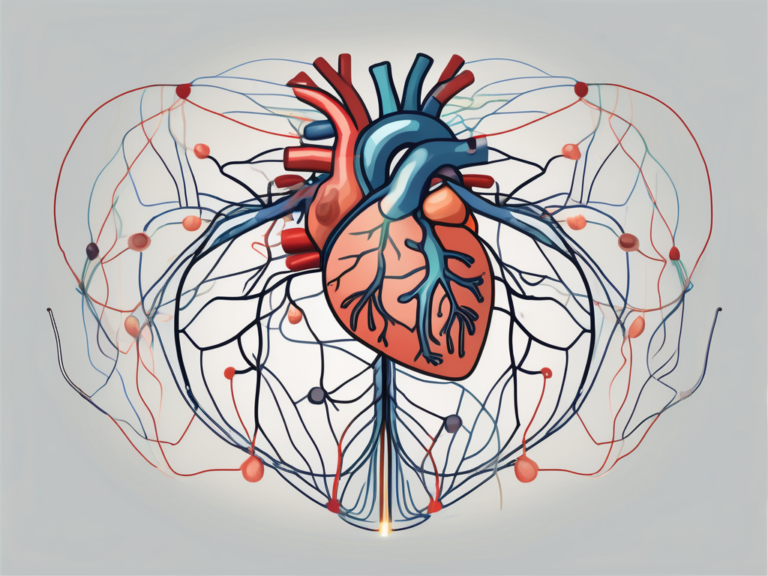Uncovering the Importance of the Perineal Nerve: Why I Heart It
As a passionate advocate for the human body’s intricate design, there is one nerve that truly captures my heart – the perineal nerve. Today, we will embark on a fascinating journey to understand the significance of this nerve and its impact on various aspects of our lives. Buckle up and let’s dive in!
Understanding the Perineal Nerve: A Brief Overview
Before we delve into the depths of the perineal nerve’s importance, let’s start with a quick primer on what this nerve is all about. Situated in the pelvic region, the perineal nerve is a branch of the pudendal nerve. It plays a crucial role in connecting the brain to the muscles and tissues in the perineum, which is the area between the genitals and the anus.
As we journey further into the intricate world of the perineal nerve, it’s fascinating to note that this nerve is not only responsible for transmitting sensory information but also for coordinating motor functions in the pelvic region. This dual role highlights the complexity and significance of the perineal nerve in our daily bodily functions.
Anatomy and Function of the Perineal Nerve
Now that we have a basic understanding of where the perineal nerve resides, let’s explore its anatomy and its unique function. The perineal nerve supplies sensation to the perineum, the external genitalia, and even the anal region. It works hand in hand with other nerves to ensure proper functioning of the bladder, urethra, anus, and genital organs.
Delving deeper into the anatomy of the perineal nerve unveils a network of intricate pathways that facilitate communication between the brain and the lower extremities. This network not only enables us to perceive touch and pain but also regulates essential bodily functions such as urination and sexual response.
Picture this: as you sit comfortably, the perineal nerve is quietly transmitting signals, allowing you to feel sensation and experience pleasure in your nether regions.
The Role of the Perineal Nerve in the Human Body
Now that we know how the perineal nerve operates, let’s explore its significance in the grand scheme of our human existence. From pain management to sexual health, this nerve has a multifaceted role in our well-being.
Furthermore, the perineal nerve’s involvement in sexual function goes beyond mere sensation. It plays a crucial role in the complex interplay of nerves and muscles required for sexual arousal and orgasm. Understanding the intricate dance between the perineal nerve and other neural pathways sheds light on the profound impact this nerve has on our intimate experiences.
The Perineal Nerve and Pain Management
If you’ve ever experienced chronic pain, you know how debilitating it can be. Well, guess what? The perineal nerve can influence pain perception and even give it a run for its money!
The perineal nerve, a branch of the pudendal nerve, plays a crucial role in sensory and motor functions in the pelvic region. It innervates the perineum, which includes the skin between the anus and the genitals, as well as the muscles in that area. This nerve is vital for maintaining normal sensation and controlling movements like urination and defecation.
The Connection Between the Perineal Nerve and Chronic Pain
Recent studies have shown a potential link between the perineal nerve and chronic pain. While the exact mechanisms are still a subject of ongoing research, understanding this connection opens doors to innovative pain management strategies.
Chronic pain conditions, such as pudendal neuralgia, where the perineal nerve is affected, can significantly impact a person’s quality of life. Symptoms may include sharp or burning pain in the pelvic region, numbness, or tingling. By delving deeper into the role of the perineal nerve in chronic pain, researchers aim to develop targeted therapies that address the root cause of these debilitating conditions.
How the Perineal Nerve Influences Pain Perception
Our perception of pain is a complex interplay of different factors, and the perineal nerve has a say in it too. By influencing the transmission and modulation of pain signals, this nerve may hold the key to unlocking new pain relief options.
Furthermore, the perineal nerve’s interaction with surrounding structures, such as the pelvic floor muscles and the pudendal canal, adds another layer of complexity to pain processing. Dysfunction or compression of the perineal nerve in these areas can lead to altered pain perception and chronic discomfort. Understanding these intricate connections is crucial for tailoring personalized pain management approaches that address the specific needs of each individual.
The Perineal Nerve and Sexual Health
Ah, the magical realm of sexual health. Brace yourselves, because the perineal nerve has quite a role to play here as well!
Exploring the intricate web of connections within the human body reveals the fascinating influence of the perineal nerve on sexual health. This nerve, often overlooked in discussions about intimacy, serves as a crucial link between physical touch and neurological response.
The Impact of the Perineal Nerve on Sexual Function
The perineal nerve is like the conductor of a symphony, orchestrating pleasure and sensation during intimate moments. It ensures that signals from the genitals travel smoothly to the brain, allowing us to appreciate the wonders of human connection.
Moreover, the perineal nerve plays a vital role in the complex dance of arousal and satisfaction. By transmitting sensory information from the perineum, it heightens our awareness of touch, contributing to the rich tapestry of sensations that define our experiences of pleasure.
The Perineal Nerve and Sexual Dysfunction
When the harmonious tune of sexual function hits a snag, the perineal nerve might be at play. Disorders like erectile dysfunction and anorgasmia can be influenced by the health and functioning of this nerve.
Furthermore, disruptions in the perineal nerve’s function can lead to challenges in sexual response, impacting not only physical well-being but also emotional and psychological aspects of intimacy. Understanding the intricate interplay between this nerve and sexual health is key to addressing and overcoming issues that may arise.
The Perineal Nerve and Childbirth
Now, let’s shift gears and explore how the perineal nerve becomes a hero during labor and delivery.
The Role of the Perineal Nerve During Labor and Delivery
As miraculous as childbirth is, it can be a challenging experience for both mother and baby. The perineal nerve contributes to the intricate process by ensuring the proper functioning of the pelvic floor muscles, aiding in a smooth and successful delivery.
During labor, the perineal nerve works in tandem with other nerves and muscles to coordinate the intricate dance of contractions and pushing. It provides sensory information to the brain, allowing the mother to feel the urge to push and guide her efforts effectively. Additionally, the perineal nerve helps in controlling the relaxation and contraction of the pelvic floor muscles, crucial for the baby’s descent through the birth canal.
Postpartum Recovery and the Perineal Nerve
After the bundle of joy arrives, the perineal nerve continues to lend a helping hand during the postpartum period. It plays a vital role in the recovery of the perineal region, assisting in healing and restoring normal function.
Postpartum, the perineal nerve supports the healing process by regulating sensations in the perineal area, aiding in pain management, and promoting tissue repair. It also contributes to the restoration of muscle tone and function in the pelvic floor, essential for postpartum recovery and long-term health. Proper care and attention to the perineal nerve during this delicate phase can significantly impact a mother’s comfort and well-being as she navigates the joys and challenges of early motherhood.
The Perineal Nerve and Pelvic Health
The power of the perineal nerve extends beyond childbirth and sexual function. Its impact on pelvic health is worth exploring.
The perineal nerve, a branch of the pudendal nerve, is a crucial player in the intricate network of nerves that innervate the pelvic region. This nerve not only provides sensation to the perineum but also contributes to the motor function of the pelvic floor muscles, aiding in their coordination and strength.
The Perineal Nerve’s Role in Maintaining Pelvic Floor Strength
You might not think about your pelvic floor muscles often, but trust me, they play a significant role in your overall well-being. The perineal nerve ensures the proper functioning and strength of these muscles, which are essential for urinary and bowel control.
In addition to its role in muscle strength, the perineal nerve also plays a part in maintaining proper blood flow to the pelvic organs. Adequate blood circulation is vital for the health and function of organs such as the bladder, uterus, and rectum, emphasizing the nerve’s broader impact on pelvic health.
The Perineal Nerve and Pelvic Disorders
When imbalances or dysfunctions occur in the pelvic floor, it can lead to various conditions such as urinary incontinence or pelvic organ prolapse. The perineal nerve’s involvement in these disorders highlights its importance in maintaining pelvic health.
Furthermore, the perineal nerve can be affected by medical conditions such as diabetes or trauma, potentially leading to symptoms like pelvic pain or altered sensation in the genital region. Understanding the intricate relationship between the perineal nerve and pelvic health is essential in addressing and managing these complex issues effectively.
The Future of Perineal Nerve Research
The perineal nerve has already filled our minds with wonder, but the intrigue doesn’t end here. Let’s take a sneak peek into the future of perineal nerve research.
Current Research Trends Surrounding the Perineal Nerve
Scientists and researchers around the world are continuing to unravel the mysteries of the perineal nerve. From exploring its connections to chronic pain to investigating potential interventions for sexual dysfunction, the future looks bright for this remarkable nerve.
Potential Implications of Future Perineal Nerve Studies
The knowledge gained from future perineal nerve studies may pave the way for innovative therapies and treatments. Imagine a world where chronic pain can be alleviated, sexual health can be improved, and pelvic disorders can be better managed.
With advancements in technology and research methodologies, scientists are delving deeper into understanding the intricate network of the perineal nerve. The utilization of cutting-edge imaging techniques, such as functional magnetic resonance imaging (fMRI) and nerve conduction studies, is shedding light on the complex pathways and functions of this nerve.
Furthermore, collaborative efforts between neuroscientists, urologists, gynecologists, and pain specialists are fostering a multidisciplinary approach to perineal nerve research. By pooling together diverse expertise and perspectives, researchers are able to tackle the multifaceted nature of perineal nerve-related conditions with a comprehensive and holistic strategy.






